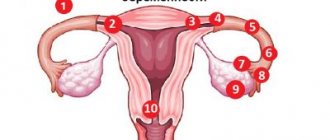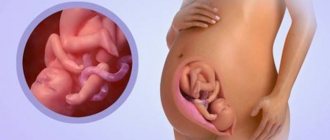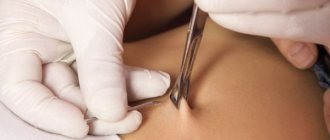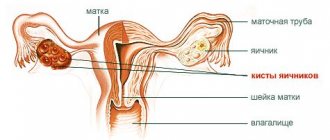Why does the belly button protrude during pregnancy?
During pregnancy, the uterus constantly increases in size, so the muscles experience greater stress.
The child develops, grows and gains weight, at this time the pressure inside the abdominal cavity increases, the uterus displaces the internal organs. This is reflected in the appearance of the navel. From about the middle of the second trimester, it takes the shape of a button and begins to bulge. The degree of convexity depends on various factors:
- on the individual body structure of a woman and anatomical features. For example, if the uterus is positioned incorrectly or the pelvis is narrow, the bulge will occur earlier and will be more noticeable;
- physical preparation of the body. In patients who regularly engage in sports, the muscles are stronger and more accustomed to stress, so they can easily withstand the pressure of the uterus. And girls with weakened abdominal muscles are subject to stretching of the umbilical ring much earlier;
- The number of pregnancies and births affects the general condition of the body. A mother with many children has a greater risk that the navel will change from the end of the first trimester than a woman in labor expecting her first child. This happens because the abdominal muscles lose elasticity each time;
- age. Young girls can bear bearing a child more easily physiologically, because the body is stronger and does not experience a lack of collagen in the ligaments than women in the 35+ category;
- excess weight. In women with a large body weight, the change in the umbilical ring is noticeable than in slimmer women in labor.
What causes navel changes during pregnancy and are they dangerous?
Pregnancy seriously affects not only a woman’s emotional and physical state, but also her appearance. Every day, changes occur in the body of the expectant mother, and the most important of them is the continuous development of the baby. Many women note that along with the growth of the abdomen, the navel changes during pregnancy.
From about 20 weeks, the navel begins to protrude forward, taking the shape of a button. Doctors consider a slight increase in the width of the umbilical ring in the absence of severe discomfort to be quite normal. Why might pain in the navel appear and how dangerous is this? Let's take a closer look.
I would like to immediately note that not all women experience significant changes in their navel. From the second half of pregnancy, when the belly begins to rapidly increase, many expectant mothers notice that the umbilical cavity gradually smoothes out and loses its usual shape. Shortly before giving birth, the navel becomes convex during pregnancy. Why is this happening?
There is no need to worry, such changes are normal. The navel will return to its previous state after pregnancy and the birth of a child. Factors influencing the change in the shape of the navel in the expectant mother are a large fetus, multiple births and polyhydramnios, rapid weight gain - under these conditions, the belly will grow faster and the navel will protrude.
Pain in the umbilical region is usually associated with the rapid growth of the unborn baby, which is noted from the 20th week of pregnancy. The skin on the abdomen is subject to excessive stretching, causing discomfort in the form of itching and pulling sensations. This is called tension pain, and the condition is not at all dangerous.
Unpleasant sensations in the navel may be associated with stretching of the umbilical ligament muscles, which have become displaced due to the rapid enlargement of the uterus.
The same discomfort can be explained by weakness of the abdominal muscles of the expectant mother. When they diverge, a phenomenon such as a blue navel during pregnancy is sometimes observed.
Shortly before childbirth, the navel muscles are stretched the most, as a result of which it protrudes forward, causing discomfort, for example, a woman may feel that her navel is itching during pregnancy. This is also normal, no need to worry. The main thing is that this condition is not accompanied by additional unpleasant symptoms.
Less commonly, pain in the navel during pregnancy may appear due to the development of pathological conditions. Therefore, if you experience any discomfort in the umbilical area, you should consult a doctor.
If your belly button hurts or is very painful during pregnancy, you should be examined by a doctor. Until a specialist arrives, it is important to remain calm, not take painkillers and not apply heat to the sore spot. It is necessary to monitor changes in health, accompanying symptoms, and tell your doctor about everything.
If diseases can be excluded, a healthy diet, wearing a special bandage for pregnant women and moderate physical activity will help eliminate nagging pain and discomfort in the umbilical area. It is also recommended to sleep exclusively on your left side, swim and walk more in the fresh air.
During pregnancy, the navel can become sick in the early stages and right up to childbirth for more dangerous reasons.
Sometimes this condition is caused by the following diseases:
- umbilical hernia;
- appendicitis;
- intestinal infection;
- diseases of the stomach, liver and pancreas;
- diseases of the urinary system;
- gynecological problems.
Nausea, lack of bowel movements, bloating, tightness and a feeling of pulsation in the umbilical area usually indicate the development of a hernia. If there are accompanying symptoms, this pathology is also indicated by a hot navel. If mechanical pressure on it causes unbearable pain, there is no doubt about the diagnosis.
Abdominal pain, diarrhea, nausea, fever are the main symptoms of an intestinal infection. Against this background, the tone of the intestinal muscles increases, and at the same time the uterus, which is fraught with the threat of miscarriage or the onset of premature labor.
Appendicitis during pregnancy is extremely rare, but if it has not been removed previously, this possibility should not be ruled out. Localization of pain to the right of the navel, increased body temperature, nausea are characteristic signs of appendicitis.
Pain occurring above the navel often indicates gastroduodenitis and other pathologies of the gastrointestinal tract. Exacerbation of existing chronic diseases of the digestive system during pregnancy is not uncommon, since all organs of the abdominal cavity have to function in slightly altered conditions.
Pain below the navel, accompanied by urinary disorders, may be associated with urological problems, such as cystitis. In this case, you should not self-medicate, since any infectious and inflammatory processes in the genitourinary system are unsafe for pregnancy.
Discomfortable sensations in the navel area with simultaneous nagging pain in the lower back and lower abdomen indicate increased uterine tone. This condition threatens the continuation of pregnancy, so it is not recommended to ignore the symptoms. For all of the above conditions, you should seek emergency help.
Many women, after the 20th week of pregnancy, notice that the navel begins to protrude outward, as if opening inside out. The less fat layer on the belly of the expectant mother, the more obvious this sign is.
The protrusion depends on the degree of stretching of the abdominal muscles and the increase in the width of the umbilical ring. Some pregnant women experience fear about this, worrying about the shape of the navel and abdomen in the future. But there is no need to worry, even if your belly button came out and sticks out during pregnancy, after childbirth everything will return to its place.
In addition to the protrusion of the navel, a woman may experience darkening of the skin in the peri-umbilical area and along the abdominal line. This occurs as a result of hormonal changes in the body of the expectant mother and the accumulation of skin pigment in these places.
A dark navel during pregnancy can be observed throughout the entire period, but 6 weeks after birth, the darkening almost completely disappears. Therefore, if the expectant mother has a darkened navel, she can be confident that its normal state will be restored.
Among modern women and girls, piercing is often a decoration for such an intimate place as the navel. Doctors have a negative attitude towards this procedure, considering it unsafe.
But, if most women get piercings earlier, long before pregnancy, some decide to perform this procedure during it. Doing this is strictly prohibited, since the wounds formed after a puncture take a long time to heal and can become inflamed.
If there is already a puncture, the woman is advised to be more attentive to her well-being during this period. The jewelry itself should be removed as soon as the tummy begins to increase in volume.
To avoid discomfort and pain in the umbilical area, you need to pay attention to prevention in advance. And the first measure would be to wear a prenatal bandage. Read more about how to choose and wear a prenatal bandage →
It is recommended to wear this device, created specifically for expectant mothers, from the 4th month of pregnancy. Its use is mandatory for rapid weight gain, repeated pregnancy, and carrying two or more fetuses.
The second preventative measure is pregnancy planning. If you conduct a preliminary examination of the body before conception and cure all detected pathologies, the risk that a woman will encounter pregnancy complications will be minimal.
In most cases, belly button pain is not a reason to panic. But if they are accompanied by additional signs of discomfort, you should consult your doctor as soon as possible. Reinsurance during pregnancy is never superfluous, even if the reason turns out to be insignificant.
Pregnancy is not only hormonal changes, but also daily external changes due to the continuous growth and development of the fetus. The belly of the expectant mother becomes larger, rounded, the skin becomes tighter, and sometimes the navel begins to protrude against this background.
From the second half of pregnancy, when the belly begins to increase significantly, the navel may also become convex. These changes are completely normal and are due to one of the following reasons:
- high water;
- rapid weight gain;
- multiple births.
In these conditions, the belly of the expectant mother rounds much faster, which is why the umbilical cavity is smoothed out, and the navel itself protrudes outward.
Pain in the navel is a rather uncomfortable feeling, both physically and mentally. It worries and makes you worry not only about your health, but also about the condition of the baby.
Reference! Nagging pain in the navel area is a type of normal.
Natural causes of belly button pain include:
- Skin stretching. The abdomen of some pregnant women increases in size very quickly, because of this the skin on it becomes very tense, which is reflected in pain in the umbilical cavity.
- Physiology. The baby grows and takes up more and more space, causing the internal organs to shift.
- Low abdominal muscle tone. In unsportsmanlike mothers, pain in the navel is much more common. This is due to the fact that the abdominal muscles simply cannot cope with the increasing load.
- Hormonal changes. In some cases, the cause of discomfort is hormones that soften ligamentous tissues.
From the above it follows that pain in the navel is normal and natural if:
- it is short-term;
- discomfort does not occur systematically;
- no bleeding;
- body temperature does not rise above normal.
In all other cases, you should consult a doctor in order to minimize the risk of miscarriage.
Monitoring changes in how you feel during pregnancy is extremely important, as cutting, stabbing, or cramping pain may indicate health problems.
If the pain in the lower abdomen radiates to the navel and is accompanied by vaginal discharge, then there are problems with the pelvic organs. In this case, you should not hesitate to visit a gynecologist, since the cause of unpleasant sensations may be:
- semolina hypertonicity;
- ectopic pregnancy;
- risk of miscarriage.
This condition is accompanied by vague symptoms of gastrointestinal disorders: constipation, heartburn, bloating, nausea and vomiting.
Important! Without timely treatment, a hernia can develop into intestinal necrosis.
What to do if your belly button protrudes too much
During normal pregnancy, a protruding navel does not cause discomfort. Small spots may also appear near it, which is also normal. Pigmentation will disappear after childbirth after some time. But sometimes the umbilical zone begins to cause discomfort, for example, pain, tingling. Such symptoms should be treated with caution. If the discomfort is not chronic and is mild, then this may occur due to the growing uterus, which displaces the internal organs and puts pressure on the abdominal muscles.
Severe painful spasms near the umbilical node should not be ignored; this may indicate a hernia. Associated symptoms:
- The area near the navel becomes hard.
- Problems with stool: constipation.
- Severe prolapse of the umbilical ring.
- Nausea.
- A hernia can be hereditary; if parents have similar problems, then there is a high risk of occurrence in children.
You should definitely consult a doctor to get an accurate diagnosis and begin treatment. Most often, a minor operation under local anesthesia is required. But they try to avoid surgical intervention, because there is a risk for the child. After the procedure you need to follow the recommendations:
- Wear a special bandage.
- Treat the navel area with cream.
- Eat properly.
- Do not lift heavy objects or do physical exercise.
In addition to a hernia, pain may indicate a malfunction in the gastrointestinal tract, chronic diseases, or intestinal infections. Therefore, it is important to promptly identify the cause and eliminate it.
Sometimes symptoms can be associated with appendicitis. This is rare. In this case, the temperature rises sharply, nausea and severe pain in the right side. You need to immediately call an ambulance.
If you suspect appendicitis, you should not self-medicate! This poses a threat to mother and child. All you need is qualified help.
How dangerous is the disease for pregnant women?
Despite the fact that this disease does not belong to the group of serious pathologies, many women still worry whether an umbilical hernia during pregnancy is dangerous.
Possible complications of an umbilical hernia during pregnancy:
- The occurrence of constipation;
- Poor circulation in the abdominal cavity and, as a consequence, in the uterus;
- Pinched hernia.
The most dangerous negative manifestation is strangulated hernia. In this condition, compression of the hernial sac occurs and complete disruption of the blood circulation of the organs.
The main causes of a pinched hernia:
- Increased intra-abdominal pressure;
- Abdominal injuries;
- Coughing;
- Surgical intervention.
Symptoms of a strangulated hernia:
- Sharp pain in the abdominal area and hernia;
- Decreased blood pressure;
- Heart rhythm disturbances;
- Pallor;
- Nausea and vomiting.
A pinched or strangulated hernia is dangerous for a woman’s condition because of poor circulation in the compressed organs. This provokes the development of tissue necrosis and concomitant peritonitis.
Consequences of a strangulated hernia for a child:
- Premature birth;
- Miscarriage;
- Fetal hypoxia.
Are there any risks for the child?
A protruding navel poses a danger to a child when combined with other diseases.
If there is a hernia, surgery is performed in extreme cases, for example, if it is strangulated. With this pathology, there is a risk of developing hypoxia, miscarriage, and premature birth, so surgical intervention is urgent. In this case, substances from anesthesia also pose a threat, because they easily penetrate the placenta and reach the child, causing a negative effect.
If these are problems with the gastrointestinal tract, then the problem is corrected by treatment. The situation is more acute with appendicitis; if you consult a doctor in time, tragic consequences can be avoided. But during surgery, the child may develop hypoxia and toxic elements from the medications that need to be taken during the rehabilitation period may penetrate. If appendicitis occurs in the late stages of pregnancy, then most likely the woman in labor will spend the remaining time before the birth of the baby in the hospital; doctors must monitor the condition. Modern medicine has stepped far forward and copes well with such cases, saving the life of the patient and the child.
If you become infected, you should immediately consult a doctor, because this is a serious threat to the child. The virus can cause the development of pathologies and affect the nervous system.
External changes in the umbilical ring and discomfort are common companions of pregnancy. This is mainly due to the growing baby displacing the internal organs and putting pressure on the abdominal muscles. It is unlikely that you will be able to avoid discomfort, especially in recent months. But you can soften them: wear a bandage, eat right and do light exercise. The main condition is regular monitoring of your well-being and appointments with a doctor.
Prevention
By following simple rules, every pregnant woman can minimize the risk of developing an umbilical hernia during pregnancy.
Prevention of umbilical hernia includes:
- Mandatory wearing of a bandage for pregnant women;
- Exercise for pregnant women;
- Weight control and adherence to nutritional rules.
It cannot be said that following these recommendations will 100% protect against the occurrence of a hernia, but will reduce the risk of development to a significant extent.
Bandages for pregnant women can be found in any pharmacy; it is only important to choose the right size. Any pharmacist can help with this issue.
An excellent option for physical education for a pregnant woman is yoga, special fitness or swimming.










